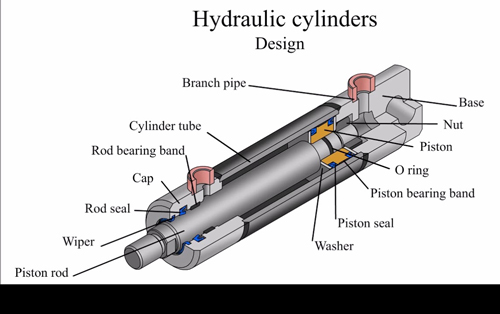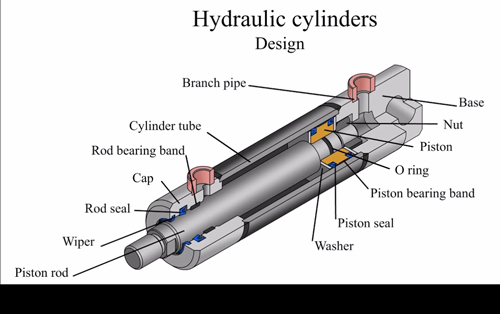
What is a Hydraulic Cylinder?

Whether you are simply wondering “what is a hydraulic cylinder?” or looking learn about hydraulic cylinder parts and how they work, or possibly are considering hydraulic cylinder repair or a hydraulic cylinder rebuild, understanding the basics of these cylinders is essential. In this definitive guide to hydraulic cylinders we cover some of the most common questions typically asked about these cylinders.
What Is a Hydraulic Actuator?
Hydraulic cylinders, or hydraulic actuators, are used extensively in several industries, including manufacturing, construction, civil engineering and aviation. These cylinders generate mechanical force in a linear motion for a variety of applications. They are typically used for pressing, pulling, pushing or lifting something that requires exceptional force.
If you’ve ever used a hydraulic jack to raise your vehicle or operated a forklift, you’ve used a hydraulic cylinder.
How Does a Hydraulic Actuator Work?
Hydraulic actuators operate on the basis of Pascal’s Principle of fluid mechanics. In the 17th century, Blaise Pascal discovered that any change in pressure in hydraulic fluid results in the equal distribution of energy in every direction in the fluid chamber. This means that if you have two pistons in one container and apply X amount of pressure on one piston, an equal X amount of pressure affects the second piston.
Pascal also discovered that the pressure in a fluid chamber equals the force applied divided by the area of the chamber. This formula P=F/A is the foundation for industrial machinery worldwide. For example, take two pistons in a fluid chamber where pressure is applied to the first cylinder. If the area is five times greater than the first area, the force on the second cylinder is five times greater.
Hydraulic Cylinder Components
Hydraulic cylinder manufacturers can build cylinders in all sizes. From micro-hydraulic cylinders weighing a few ounces to massive industrial cylinders used with excavating shovels, hydraulic actuators generally contain the same basic components:
- Piston: The piston rod extends through the head of the cylinder and utilizes the forces of the hydraulic fluid to retract or extend. Seals are placed around the piston to maintain the correct pressure in the barrel.
- Cylinder barrel: The barrel is constructed of a seamless steel tube that houses the cylinder. The barrel’s solid structure holds the pressure and prevents leaking.
- Cylinder head: The head is the part of the cylinder where the piston retracts and extends. When the piston extends, the other end of the barrel is closed off to maintain pressure. The head contains the bearings and seals that align the piston and keep the cylinder sealed.
- Cylinder base: The barrel is enclosed at the cylinder base and sealed tight to prevent fluid leaks. The equipment that uses the cylinder is mounted at the base.
- Gaskets, seals and other components: The seals and gaskets in a hydraulic actuator are dynamic components that must withstand extreme pressures and temperatures without failing. The seals are made from different materials, including Teflon, polyurethane, fluorocarbon, metal and nitrile rubber. Some materials like rubber are suited for low-temperature operation, but for high-temperature jobs, the seals are fluorocarbon.
Hydraulic vs Pneumatic Cylinders
While hydraulic cylinders use incompressible fluid (typically mineral oil) to generate linear motion, a pneumatic cylinder relies on compressed air powered by a compressor or hand pump to create linear motion. Although both types of cylinders are used throughout the world, each type has its advantages and disadvantages.
Hydraulic Cylinder Advantages
The horsepower-to-weight ratio of a hydraulic cylinder is superior to that of a pneumatic cylinder, with hydraulics gaining one or two horsepower per pound. When it comes to power, a hydraulic cylinder can create a mechanical force that is 25 times more powerful than a pneumatic cylinder with the exact dimensions.
Unlike pneumatic cylinders that max out at 250 psi, a top-of-the-line hydraulic pump can produce 4000 psi. Since the hydraulic fluid is incompressible, hydraulic cylinders do not need additional fluid added to maintain constant force and torque. Even if the hydraulic pump and motor are located a significant distance from the operation, they can function efficiently without a noticeable loss of power.
Hydraulic Cylinder Disadvantages
Hydraulic cylinders are more complex than pneumatic models and require several additional components, including release valves, pumps, motors, reservoirs and heat exchangers. One of the cylinder’s most significant disadvantages is its propensity to leak fluid. Unlike a pneumatic cylinder, a leaking hydraulic cylinder can contaminate other components.
Pneumatic Cylinder Advantages
Pneumatic cylinders are far less complex than hydraulics, but they’re incredibly accurate in creating linear motion. Pneumatic actuators excel at operating in extreme temperatures and typically work within a range of -40°F to 250°F. In extreme conditions, pneumatics pose less of a fire hazard or explosion risk due to their reliance on compressed air that does not require a motor to operate. Compared to hydraulic cylinders, pneumatics are less expensive to purchase and operate.
Pneumatic Cylinder Disadvantages
Unlike hydraulics that can be used with several applications, pneumatic actuators are machined for one task unless valves and regulators are added to modify the cylinder. Although compressed air is cheap and widely available, it can damage the equipment when contaminated by oil or lubricant. Pneumatic cylinders are also less efficient because the compressor must constantly run even if the cylinder isn’t moving.
Types of Hydraulic Cylinders
There are many types of hydraulic cylinders for sale, with these being the four most common:
Single-acting cylinders
Single acting hydraulic cylinders produce power when hydraulic fluid enters a single port and flows into the cylinder and causes the cylinder to retract. Also called push cylinders, they feature a single-acting piston that moves in one direction and requires a motor or spring to reset its position.
Double-acting cylinders
In double acting hydraulic cylinder models, fluid moves into one port and exits through a second port, forcing the cylinder to retract and extend. With two pressurized chambers, double-acting pistons do not require a spring or motor to operate.
Telescopic cylinders
In heavy equipment like cranes, telescopic cylinders utilize a series of single-acting cylinders. When one cylinder retracts, it transfers force to the next cylinder.
Tandem cylinders
With two separate barrels connected by the piston rods, the tandem cylinder design achieves a significant degree of force in a small area. Tandem cylinders can be combined in stages to provide more power.
How To Choose a Hydraulic Actuator
After determining the application that requires a hydraulic linear actuator, you must consider several factors before selecting the ideal actuator. The planning and design process is vital for operating an efficient hydraulic operation, and the primary elements in the process include:
- Calculating Mass: The mass of the object being lifted by hydraulics affects the size and durability of the cylinders.
- Determining the physics involved: Are hydraulics needed for a simple pressing operation, or does it involve more complex movements?
- Calculating the bore size: Larger barrels can accommodate applications that require significant force and torque.
- Selecting the rod size: The length of the cylinder stroke, the bearing load and the rod buckling strength can help determine the appropriate rod size. If standard cylinders are unusable with the bore size, custom cylinders can be manufactured for the ideal fit.
- Examining the cushion options: If the hydraulic application requires the cylinder rods to move at high speeds, cushioning can be used at either cylinder end to dampen the impact.
What Are Hydraulic Linear Actuators Used for?
Hydraulic linear actuators are used in countless applications in every corner of the globe. Compared to other actuators, hydraulic cylinders are more efficient, powerful and durable. In the mobile equipment industry, hydraulics are exclusively used on excavators, bulldozers, dump trucks, graders and loaders.
Manufacturing plants rely on hydraulic actuators to operate forging presses, injection molders, compactors and other heavy equipment.
Single-Acting Hydraulic Cylinder vs Double-Acting
Hydraulic equipment and machines utilize single-acting and double-acting cylinders, and each type has its advantages. Single-acting cylinders are simpler and easier to maintain than double-acting cylinders. However, with more fluid in the pressurized chamber, double-acting actuators are easier for an operator to control.
Hydraulic Cylinder Suppliers
As leading hydraulic cylinder suppliers for over 50 years, we provide our clients a wide range of cylinders and repair any brand or style of cylinder. Here are some of the hydraulic linear cylinders we offer:
- Welded cylinders
- Mill duty cylinders
- Tie rod cylinders
- Custom hydraulic cylinders
- Single-acting hydraulic cylinders
- Double-acting hydraulic cylinders
- Large bore cylinders
- Tandem hydraulic cylinders
- Stainless steel hydraulic cylinders
- Duplex hydraulic cylinders
Along with this vast inventory of cylinders, we can also design and build a custom cylinder that meets your needs.